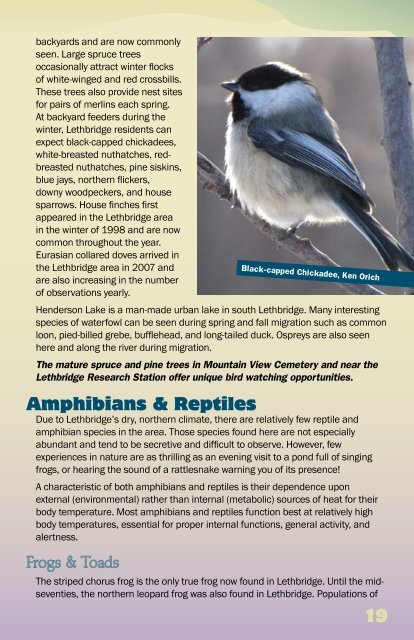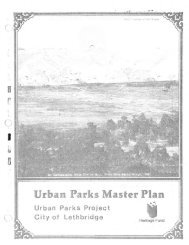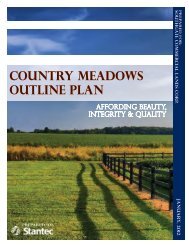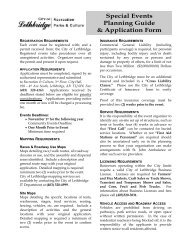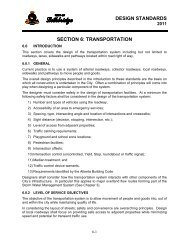Coulees Cottonwoods - City of Lethbridge
Coulees Cottonwoods - City of Lethbridge
Coulees Cottonwoods - City of Lethbridge
You also want an ePaper? Increase the reach of your titles
YUMPU automatically turns print PDFs into web optimized ePapers that Google loves.
ackyards and are now commonly<br />
seen. Large spruce trees<br />
occasionally attract winter flocks<br />
<strong>of</strong> white-winged and red crossbills.<br />
These trees also provide nest sites<br />
for pairs <strong>of</strong> merlins each spring.<br />
At backyard feeders during the<br />
winter, <strong>Lethbridge</strong> residents can<br />
expect black-capped chickadees,<br />
white-breasted nuthatches, redbreasted<br />
nuthatches, pine siskins,<br />
blue jays, northern flickers,<br />
downy woodpeckers, and house<br />
sparrows. House finches first<br />
appeared in the <strong>Lethbridge</strong> area<br />
in the winter <strong>of</strong> 1998 and are now<br />
common throughout the year.<br />
Eurasian collared doves arrived in<br />
the <strong>Lethbridge</strong> area in 2007 and<br />
are also increasing in the number<br />
<strong>of</strong> observations yearly.<br />
Henderson Lake is a man-made urban lake in south <strong>Lethbridge</strong>. Many interesting<br />
species <strong>of</strong> waterfowl can be seen during spring and fall migration such as common<br />
loon, pied-billed grebe, bufflehead, and long-tailed duck. Ospreys are also seen<br />
here and along the river during migration.<br />
The mature spruce and pine trees in Mountain View Cemetery and near the<br />
<strong>Lethbridge</strong> Research Station <strong>of</strong>fer unique bird watching opportunities.<br />
Amphibians & Reptiles<br />
Due to <strong>Lethbridge</strong>’s dry, northern climate, there are relatively few reptile and<br />
amphibian species in the area. Those species found here are not especially<br />
abundant and tend to be secretive and difficult to observe. However, few<br />
experiences in nature are as thrilling as an evening visit to a pond full <strong>of</strong> singing<br />
frogs, or hearing the sound <strong>of</strong> a rattlesnake warning you <strong>of</strong> its presence!<br />
A characteristic <strong>of</strong> both amphibians and reptiles is their dependence upon<br />
external (environmental) rather than internal (metabolic) sources <strong>of</strong> heat for their<br />
body temperature. Most amphibians and reptiles function best at relatively high<br />
body temperatures, essential for proper internal functions, general activity, and<br />
alertness.<br />
Frogs & Toads<br />
Black-capped Chickadee, Ken Orich<br />
The striped chorus frog is the only true frog now found in <strong>Lethbridge</strong>. Until the midseventies,<br />
the northern leopard frog was also found in <strong>Lethbridge</strong>. Populations <strong>of</strong><br />
19


